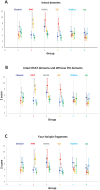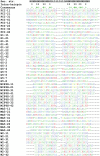The PCI domains are "winged" HEAT domains
- PMID: 36094910
- PMCID: PMC9467303
- DOI: 10.1371/journal.pone.0268664
The PCI domains are "winged" HEAT domains
Abstract
The HEAT domains are a family of helical hairpin repeat domains, composed of four or more hairpins. HEAT is derived from the names of four family members: huntingtin, eukaryotic translation elongation factor 3 (eEF3), protein phosphatase 2 regulatory A subunit (PP2A), and mechanistic target of rapamycin (mTOR). HEAT domain-containing proteins play roles in a wide range of cellular processes, such as protein synthesis, nuclear transport and metabolism, and cell signaling. The PCI domains are a related group of helical hairpin domains, with a "winged-helix" (WH) subdomain at their C-terminus, which is responsible for multi-subunit complex formation with other PCI domains. The name is derived from the complexes, where these domains are found: the 26S Proteasome "lid" regulatory subcomplex, the COP9 signalosome (CSN), and eukaryotic translation initiation factor 3 (eIF3). We noted that in structure similarity searches using HEAT domains, sometimes PCI domains appeared in the search results ahead of other HEAT domains, which indicated that the PCI domains could be members of the HEAT domain family, and not a related but separate group, as currently thought. Here, we report extensive structure similarity analysis of HEAT and PCI domains, both within and between the two groups of proteins. We present evidence that the PCI domains as a group have greater structural similarity with individual groups of HEAT domains than some of the HEAT domain groups have among each other. Therefore, our results indicate that the PCI domains have evolved from a HEAT domain that acquired a WH subdomain. The WH subdomain in turn mediated self-association into a multi-subunit complex, which eventually evolved into the common ancestor of the Proteasome lid/CSN/eIF3.
Conflict of interest statement
The authors have declared that no competing interests exist.
Figures





Similar articles
-
Prediction of a common structural scaffold for proteasome lid, COP9-signalosome and eIF3 complexes.BMC Bioinformatics. 2005 Mar 24;6:71. doi: 10.1186/1471-2105-6-71. BMC Bioinformatics. 2005. PMID: 15790418 Free PMC article.
-
Crystal structure and versatile functional roles of the COP9 signalosome subunit 1.Proc Natl Acad Sci U S A. 2013 Jul 16;110(29):11845-50. doi: 10.1073/pnas.1302418110. Epub 2013 Jul 1. Proc Natl Acad Sci U S A. 2013. PMID: 23818606 Free PMC article.
-
PCI proteins eIF3e and eIF3m define distinct translation initiation factor 3 complexes.BMC Biol. 2005 May 17;3:14. doi: 10.1186/1741-7007-3-14. BMC Biol. 2005. PMID: 15904532 Free PMC article.
-
PCI complexes: Beyond the proteasome, CSN, and eIF3 Troika.Mol Cell. 2009 Aug 14;35(3):260-4. doi: 10.1016/j.molcel.2009.07.009. Mol Cell. 2009. PMID: 19683491 Review.
-
The COP9 signalosome: mediating between kinase signaling and protein degradation.Curr Protein Pept Sci. 2004 Jun;5(3):185-9. doi: 10.2174/1389203043379792. Curr Protein Pept Sci. 2004. PMID: 15180523 Review.
Cited by
-
MRO/HNRNPU/CCL5 feedback loop amplifies M2 macrophage and breast cancer cell crosstalk to drive progression.J Transl Med. 2025 Aug 15;23(1):920. doi: 10.1186/s12967-025-06776-w. J Transl Med. 2025. PMID: 40817243 Free PMC article.
References
Publication types
MeSH terms
Substances
Grants and funding
LinkOut - more resources
Full Text Sources
Miscellaneous

